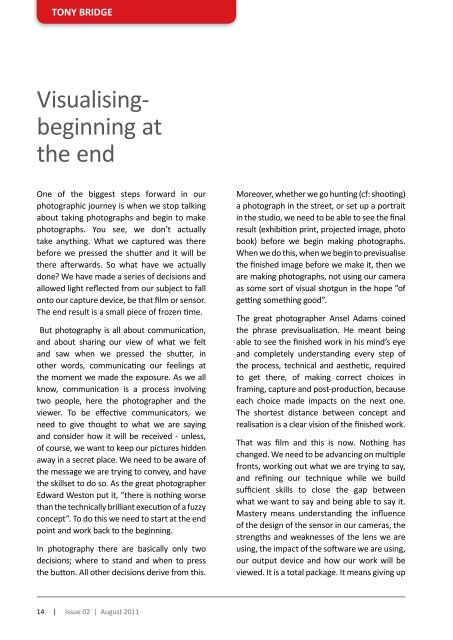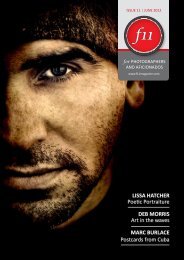SUE BRYCE Portrait Couture CAMUS WYATT Unobtrusive LEON - f11
SUE BRYCE Portrait Couture CAMUS WYATT Unobtrusive LEON - f11
SUE BRYCE Portrait Couture CAMUS WYATT Unobtrusive LEON - f11
Create successful ePaper yourself
Turn your PDF publications into a flip-book with our unique Google optimized e-Paper software.
TONY BRIDGE<br />
Visualising-<br />
beginning at<br />
the end<br />
One of the biggest steps forward in our<br />
photographic journey is when we stop talking<br />
about taking photographs and begin to make<br />
photographs. You see, we don’t actually<br />
take anything. What we captured was there<br />
before we pressed the shutter and it will be<br />
there afterwards. So what have we actually<br />
done? We have made a series of decisions and<br />
allowed light reflected from our subject to fall<br />
onto our capture device, be that film or sensor.<br />
The end result is a small piece of frozen time.<br />
But photography is all about communication,<br />
and about sharing our view of what we felt<br />
and saw when we pressed the shutter, in<br />
other words, communicating our feelings at<br />
the moment we made the exposure. As we all<br />
know, communication is a process involving<br />
two people, here the photographer and the<br />
viewer. To be effective communicators, we<br />
need to give thought to what we are saying<br />
and consider how it will be received - unless,<br />
of course, we want to keep our pictures hidden<br />
away in a secret place. We need to be aware of<br />
the message we are trying to convey, and have<br />
the skillset to do so. As the great photographer<br />
Edward Weston put it, “there is nothing worse<br />
than the technically brilliant execution of a fuzzy<br />
concept”. To do this we need to start at the end<br />
point and work back to the beginning.<br />
In photography there are basically only two<br />
decisions; where to stand and when to press<br />
the button. All other decisions derive from this.<br />
Moreover, whether we go hunting (cf: shooting)<br />
a photograph in the street, or set up a portrait<br />
in the studio, we need to be able to see the final<br />
result (exhibition print, projected image, photo<br />
book) before we begin making photographs.<br />
When we do this, when we begin to previsualise<br />
the finished image before we make it, then we<br />
are making photographs, not using our camera<br />
as some sort of visual shotgun in the hope ”of<br />
getting something good”.<br />
The great photographer Ansel Adams coined<br />
the phrase previsualisation. He meant being<br />
able to see the finished work in his mind’s eye<br />
and completely understanding every step of<br />
the process, technical and aesthetic, required<br />
to get there, of making correct choices in<br />
framing, capture and post-production, because<br />
each choice made impacts on the next one.<br />
The shortest distance between concept and<br />
realisation is a clear vision of the finished work.<br />
That was film and this is now. Nothing has<br />
changed. We need to be advancing on multiple<br />
fronts, working out what we are trying to say,<br />
and refining our technique while we build<br />
sufficient skills to close the gap between<br />
what we want to say and being able to say it.<br />
Mastery means understanding the influence<br />
of the design of the sensor in our cameras, the<br />
strengths and weaknesses of the lens we are<br />
using, the impact of the software we are using,<br />
our output device and how our work will be<br />
viewed. It is a total package. It means giving up<br />
sleep – for years, perhaps even decades.<br />
And it helps to have one of the greats as a<br />
mentor somehow looking over your shoulder.<br />
I fell in love with Ansel’s Clearing Winter<br />
Storm, Yosemite about 25 years ago. I wanted<br />
to make an image as exquisitely detailed,<br />
which showed all the intricacy and grandeur of<br />
nature. It took a while. Then, one day, on the<br />
Borland Saddle, looking at a receding autumn<br />
storm, I had my chance. Shot with a Canon 1DS<br />
Mk III and 24-70/2.8L lens, it took every trick in<br />
my book to achieve it; mirror lockup, remote<br />
release, 12kg tripod (it was blowing 40 knots),<br />
triple Lee grad filters and seventy attempts to<br />
make a photograph which encompassed what<br />
I felt and saw - in that order.<br />
2 frames worked.<br />
Only one will ever be printed.<br />
TB<br />
tony@<strong>f11</strong>magazine.com<br />
Borland Saddle, New Zealand. © Tony Bridge.<br />
Clearing Winter Storm, Yosemite National Park,<br />
California, 1944. © Estate of Ansel Adams.<br />
www.thistonybridge.com<br />
www.centreofthecompass.com<br />
14 | Issue 02 | August 2011 <strong>f11</strong> for PhoToGrAPhErS And AfICIonAdoS | 15



